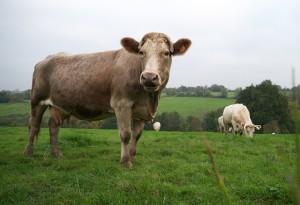Search Results for Tag: FAO
Study says livestock emissions can be cut by 30 percent
We’ve all heard about how cows and other grass-eating cattle release methane, a powerful greenhouse gas (GHG), when they belch and fart. The United Nations has suggested in the past that the environmental impact of cattle might be even more damaging than the emissions of cars and trucks combined. Now, a new study by the Food and Health Organization (FAO) says that greenhouse gas emissions by the livestock sector could be cut by as much as 30 percent if farmers adopt better techniques within existing production systems.
Titled, Tackling climate change through livestock: A global assessment of emissions and mitigation opportunities, the new study says emissions linked to livestock supply chains add up to 7.1 gigatonnes of carbon dioxide equivalent (CO2-eq) per year – or 14.5 percent of all human-caused GHG releases.
That’s less than the 18 percent that was cited by the FAO in a widely-quoted study in 2006 (Livestock’s Long Shadow) on emissions linked to global meat production. The FAO says the new figure is based on a new revised modelling framework and updated data.
The latest report pinpoints the main sources of emissions at different stages of various livestock supply chains – food production and processing (45 percent of the total), outputs of greenhouse gases during digestion by cows (39 percent) and manure decomposition (10 percent).
So, how can livestock production – a wide-ranging, globe-spanning activity which varies greatly from country to country – lower its emissions? The FAO says it will require a mix of policies, incentives, and on-the-ground work.
The FAO study however says there is no need to shift from small-scale and backyard to industrial livestock farming. It says farmers need to more widely adopt best practices and technologies in feeding, health, husbandry and manure monitoring as well as make greater use of underused technologies such as biogas generators and energy saving devices.
“These efficiency gains can be achieved by improving practices, and don’t necessitate changing production systems,” Ren Wang, FAO assistant director general for agriculture and consumer protection, says. “But we need political will, better policies and most importantly, joint action.”
Stop food waste for climate’s sake
No question, food waste is not good at all. Now, the FAO expressed in numbers how bad it really is – for climate and environment. So, if you need some astonishing reasons to change something – here you go:
In total, one third of the world’s food production is wasted or lost each year.
The carbon footprint of the food wasted is 3.3 gigatons of CO2 equivalent – which makes food waste the third biggest CO2 emitter after the US and China.
The fresh water we are wasting by wasting food equals 250 km³ – three times the volume of the Lake Geneva and enough to meet the water demand of all people in the world.
Growing the amount of wasted food occupied a 1.4 billion hectares of land which equals about 30 percents of the world’s agricultural land or the land area of China, Mongolia and Kazakhstan altogether.
If you are more a economist kind of person: the economic loss that comes along with this extensive food waste is 750 billion US-Dollar or in other words: the GDP of Switzerland, one of Europe’s stablest economies.
If you know think this it not your problem to solve but a task for companies and politicians – you are, well, not wrong, but not right neither. Here’s a little video produced by the FAO that shows, what can be done.
A comprehensive inventory of Tanzania’s forests
Nearly 20% of green house gas emissions worldwide are caused by deforestation and forest degradation in developing countries. Estimating and reducing these emissions is therefore one of the key goals for the international community as the Rio+20 conference on sustainable development in June draws closer. One country attempting to do just that is Tanzania. The country is currently in the process of drawing up a comprehensive inventory of its forests as you can see in the video above by the Food and Agriculture Organization of the United Nations (FAO). The inventory is meant to help the East African country to better manage its natural resources. Today more than a third of Tanzania is forested, but almost 1% of that forest is being lost annually. The inventory will measure how much carbon is stored within Tanzania’s forests and will help the country to understand the role it can play in mitigating climate change.
French
Spanish
Acacia trees help combat desertification
In Africa’s Sahel region people are trying to push back the frontiers of the Sahara desert – or at least halt its continuing expansion into what used to be arable lands. Deforestation and ensuing soil erosion are a major cause for desertification. Replanting trees may stem the trend – and help local inhabitants earn their living. One example is this project initiated by the Food & Agriculture Organisation of the UN (FAO):
2011 – International Year of Forests
2011 is the International Year of Forests, declared by the United Nations. We would like to suggest the project's website to you and a very interesting youtube channel that the project has launched.
The promotion of 2011 as a special year will show people's actions to sustainably manage the world’s forests, the UN says. It is also meant to raise awareness of sustainable management, conservation and development of all types of forests. As we have seen in some of our GLOBAL IDEAS reports this year, forests do have a key role in global sustainable development. According to the World Bank, more than 1.6 billion people depend on forests for their livelihoods. The UN’s Food and Agriculture Organization (FAO) estimates that every year 130,000 km2 of the world's forests are lost due to deforestation. Have a look at their channel, here's a glimpse:














Feedback